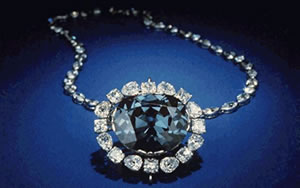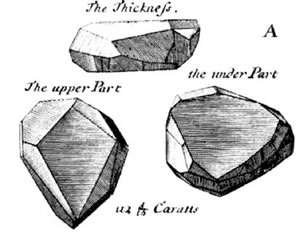The 45.52 carat steel blue Hope Diamond was found in India back in remote times as a rough crystal weighing 112 carats. It first came to light when Jean Baptiste Tavernier, the noted French traveler of the 17th century, was approached in Indian by a slave who had a very secretive manner about him.
It turned out that he had in his possession an intriguing steel blue stone which at first look seemed to be a large sapphire, but the well-experienced Tavernier soon realized it was a diamond – the largest deep blue diamond in the world.
Tavernier’s diagram of the Hope Diamond’s 112-carat rough form.
Legend has it the diamond came from the eye of an idol in a temple on the Coleroon River in India. If that is so, one can only conjecture that the eye must have had a mate, but the fate of “the other eye” has never come to light. It would not be the first famous diamond that started it’s notoriety in a religious idol. The Idol’s Eye and the Orlov both came from idols, according to legend. Tavernier purchased the diamond and smuggled it to Paris, where he later sold it to King Louis XIV. It was cut there into a triangular-pear-shaped stone weighing 67.50 carats, and was then known as the French Blue or the Tavernier Blue.
The legends of the ill-fortune following the possessor of the Hope Diamond are many. From the start Louis XIV, for whom Louisiana was named by La Salle, who claimed the lower Mississippi in his name, (and was killed by his own men) had ill-fortune follow him, perhaps deservedly.
Louis XIV gave the diamond to Madame de Montespan, but she soon went into royal discard. Then came a day when a great festival was given in honor of the King. The Director of Finance, Nicolas Fouquet, had planned well for the occasion, hoping to impress the court. What matter if France was tottering on the brink of revolution, and the nation’s finances none too stable? Was not he, Nicolas Fouquet, reputedly a wealthy man?
So he would borrow the diamond and the king, he though, would be pleased with such a man of impressively good taste. It didn’t work out that way. After the party, Louis XIV had Nicolas arrested for embezzlement, regained the diamond, and Fouquet was made a prisoner of the Crown at the Fortress of Pignerol where he died 15 years later after plenty of time to contemplate the famous curse.
Other wearers of the diamond at the Court of France might well have given credence to the legendary curse. Princess de Lamballie, and Marie Antoinette whole followed, both were guillotined during the French Revolution.
The diamond disappeared, and for many years it was not heard from at all, but in 1830, a large steel blue diamond of a different shape, and weighing only 44.50 carats appeared on the market in England was purchased by Henry Thomas Hope, an English banker. In 1851 the diamond was shown at a London exhibition and was insured for a million dollars, an unbelievable amount of money for the time period, but then again, this was the largest diamond of its type in the world.
The diamond was later inherited by a descendant, Lord Francis Pelham Clinton Hope. His wife, formerly a prominent American actress, May Yohe, and a stage star at the beginning of the 20th century, ran away with another man. She died in Boston, Mass., in 1913, practically penniless and forgotten. She had little regard for the Hope Diamond, and wrote the then owner, Evalyn Walsh McLean, commenting unfavorably on the diamond and the misfortune of its owners. Lord Hope eventually went bankrupt and again, the diamond vanished, only to be discovered by the estate trustees after it had been sold as a piece of costume jewelry and lightly regarded.
 The next owner of the Hope Diamond was Abdul Hamid II, Sultan of Turkey, Caliph of Israel, Prince of the Faithful, Master of the World (plus a few more lowly titles). His subjects called him Abdul the Damned and did not take lightly to his despotic rule. He squeezed $450,000 out of his subjects and paid the sum to a syndicate of diamond dealers. Then he gave the diamond to Subaya, one of the four wives and 233 concubines who shared his harem. She wore the diamond well, but not well enough, and started palace intrigue against the Sultan, who found out and had her executed.
The next owner of the Hope Diamond was Abdul Hamid II, Sultan of Turkey, Caliph of Israel, Prince of the Faithful, Master of the World (plus a few more lowly titles). His subjects called him Abdul the Damned and did not take lightly to his despotic rule. He squeezed $450,000 out of his subjects and paid the sum to a syndicate of diamond dealers. Then he gave the diamond to Subaya, one of the four wives and 233 concubines who shared his harem. She wore the diamond well, but not well enough, and started palace intrigue against the Sultan, who found out and had her executed.
One day, Mrs. Evalyn Walsh McLean attended a Turkish Court function and saw the famous blue diamond. She longed to possess it again. Years passed and finally Abdul realized that his subjects had some rights, and the pressures of the political system were upon him. He had the diamond smuggled to Paris to be sold. Meanwhile, he was dethroned and received not a penny for the diamond since the proceeds were seized by his successors in government. Mrs. McLean bought the stone in January, 1911 and frequently wore it at her famous Washington parties. In 1949, two years after her death, Harry Winston purchased the McLean collection which contained not only the Hope Diamond, but the Star of the East Diamond as well. He later gave the diamond to the nation, and it is now on display in Washington D.C.
The world contains many diamonds of great repute. But by all standards of comparison, for fame or infamy, no other jewel so captured the imagination as did the Hope Diamond and its predecessor the French Blue. Truly it is the Queen of the Court of Jewels.
In 1975, the diamond was removed from its setting to be cleaned and weighed. It turned out to actually weigh 45.52 carats rather than 44.50 carats, which is what was previously thought. Many people also believe the Hope Diamond is the largest blue diamond in the world, this isn’t true, though. It’s actually the 4th largest. It is however, the largest dark blue. The other larger blue diamonds are lighter shades.
Rubies and the unique Hope Diamond exhibits fluorescence which is an extremely unusual red. The stone emits a dim light under ultraviolet light, but when the light source is removed, the diamond produces brilliant red phosphorescence. No doubt this unique characteristic has influenced the legend of its curse.
In December of 1988, a team from the Gemological Institute of America visited the Smithsonian to grade the great blue stone according to present day techniques. They observed that the gem shows evidence of wear, has remarkably strong phosphorescence, and that its clarity is slightly affected by a whitish graining that is common to blue diamonds. They described the diamond color as fancy dark grayish-blue. In 1996, after another examination they described the color as fancy deep grayish-blue. An examination on the same day in 1988 by another gemologist using a very sensitive colorimeter revealed that there is a very slight violet component to the deep blue color which is imperceptible to the naked eye.

